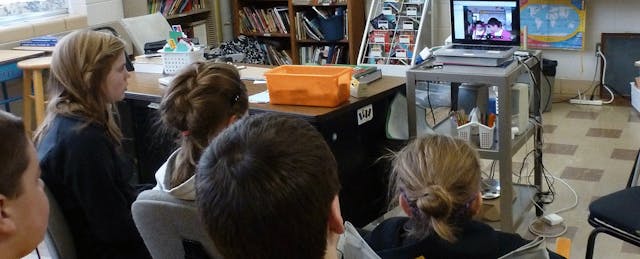This year, I made a vow to my students that they would become global learners, understanding how to celebrate differences, appreciate cultures, and gain a newfound knowledge of what one can truly do in geography.
The Kansas Standards for History, Government and Social Studies for third grade state that students need to understand how different customs and cultural traditions shape communities, describe human characteristics of your community with another community, read maps to analyze city locations and problem solve, exhibit mental mapping skills and locate places based on absolute and relative location.
There were two choices of how I could teach this. I could find videos and worksheets on maps, or I could use this as a way to connect students with other students and experts around the world.
Getting Started With Mystery Skypes
Over the summer, I finally took the time to research more about Mystery Skypes. I discovered it was a game where classes would ask yes and no questions to determine where the other class was located. The class who figured it out first was the winner. Quickly, I went to Skype in the Classroom and signed up as a Mystery Skype participant. After doing this, I started receiving all types of emails about collaborating together.
Our first Skype was with Mr. Iversen’s class at Escola Americana School in Rio de Janeiro. My third grade students were in awe when they realized the other class was not in the United States. As I was looking at students, I heard, “What is happening?” “This is SO cool. I love these accents!” Students had maps everywhere, were using picture clues and listening intently to receive a yes or no to the question. When their location was discovered, students were even more excited because they had recently watched the World Cup this summer and were amazed to know they were having discussions with students in Brazil.
Our next Mystery Skype was with Neil Armstrong Academy in West Valley City, Utah. It was in this Skype that students learned about time zones. What? We live in the Central Standard Time Zone? Everyone in the United States doesn’t have the same time? Students now understood why they were asking us about time zones. From this question, students quickly added it to their list of questions to ask in the next Skype.
To work on descriptive writing, we collaborated with two second grade classes at Leman Manhattan Preparatory School in New York City. We did a monster writing project where the students drew a monster and used description and technical writing to depict how it looked. We sent each other the writing and had to try to draw the monster. Later, we had a Skype where we shared our monsters and discussed what we could have done to make it easier to draw the monster.
Learning Lessons Beyond Curriculum
To learn more strategies with conflict resolution, we partnered with Mrs. Marsh’s class at Tskuba International School in Japan. Because of the time differences, we were unable to talk live, but we each created videos showing different ways we resolve conflict. In class, we were able to discuss new strategies we could implement if we had a conflict with one another.
Through the Mystery Skype with Mrs. Ari’s class in Israel, students realized their tornado drills weren’t so bad after students shared they have war drills, where they go to emergency rooms to stay safe from bombs.
Students have even come as early as two hours before school start to Skype. They came at 7:00am to speak with children at the Cheery Centre in Nairobi, Kenya. Through this Skype, students saw what life was like living in the Kibera slum. They saw a narrow classroom with bare walls. Many of these children were orphaned, losing their parents to AIDS or other diseases. Despite these obstacles, happy children with smiles a mile wide were eager to speak with my students. They wanted to know what they valued about school and about their favorite subjects. Through this Skype, my students learned the importance of not taking their education for granted.
Currently, we are in the middle of a bouncing story writing project with two classrooms at the Beaconhouse School in Pakistan. Students write two pages, then their partner writes another two, then we write two more, then their partner ends the story. It is going to culminate with a Skype where the students are going to discuss their story. Through this partnership, students have been able to change preconceived stereotypes of the Middle East being a place filled with negativity, understanding these children want to learn like them.
Through four months of school, we have collaborated with 33 classrooms in 14 different countries. What started as bringing real-world connections and global collaboration to students has truly become a learning adventure for all of us. Be a risk taker and take your students beyond your classroom walls: You will experience learning outcomes you never would have imagined.


